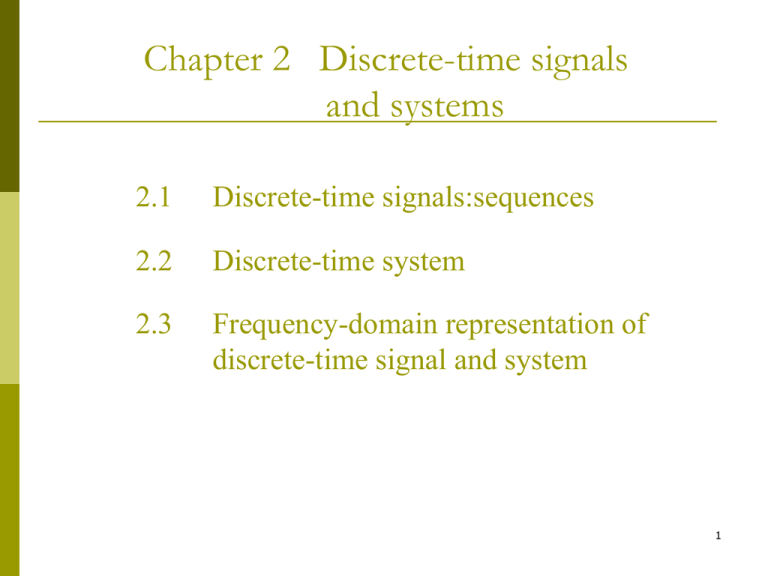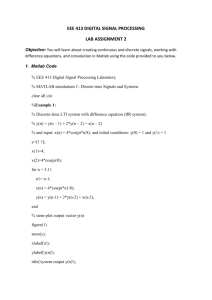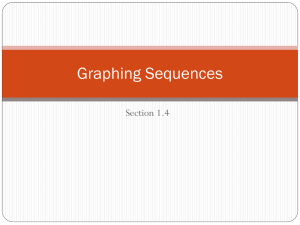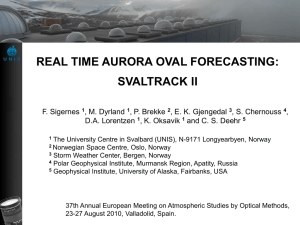Chapter 2
advertisement

Chapter 2 Discrete-time signals
and systems
2.1
Discrete-time signals:sequences
2.2
Discrete-time system
2.3
Frequency-domain representation of
discrete-time signal and system
1
2.1 Discrete-time signals:sequences
2.1.1 Definition
2.1.2 Classification of sequence
2.1.3 Basic sequences
2.1.4 Period of sequence
2.1.5 Symmetry of sequence
2.1.6 Energy of sequence
2.1.7 The basic operations of sequences
2
2.1.1 Definition
x x[n]
EXAMPLE
n
Enumerative
representation
x[n] {1,2,1.2,0,1,2,2.5},1 n 5
x[n] 0.9 cos(0.2n / 2),0 n 10
n
Function
representation
3
2
0.5
1
0
0
-1
-0.5
-2
-3
-2
-1
0
2
4
6
0
5
10
Graphical
representation
4
Generate and plot the
sequence in MATLAB
n=-1:5
x=[1,2,1.2,0,-1,-2,-2.5]
stem(n,x, '.')
n=0:9
y=0.9.^n.*cos(0.2*pi*n+pi/2)
stem(n,y,'.')
5
x[n] xa (t ) |t nT xa (nT )
EXAMPLE
Sampling the
analog
waveform
Figure 2.2
6
Display the wav speech signal in ULTRAEDIT
7
Display the wav speech signal in COOLEDIT
The whole
waveform
Display the wav speech signal in
local Blowup
8
2.1.2 Classification of sequence
Right-side
x[n] 0, for n N
Left-side
x[n] 0, for N n
Two-side
x[n] 0, for n
Finite-length
x[n] 0, outside of N1 n N2
Causal
x[n] 0, for
n0
Noncausal
x[n] 0, for n 0
9
2.1.3 Basic sequences
1. Unit sample sequence
1
[ n]
0
n0
1
n0
n
0
2.The unit step sequence
1
u[n]
0
δ[n]
n0
u[n]
1
n0
n
0
3.The rectangular sequence
1
RN [ n ]
0
0 n N 1
other
R[n]
1
10
0
N-1
n
4. Exponential sequence
x[n] a n
11
x[n] a n (re j ) n
12
5. Sinusoidal sequence
x[n] A cos(n )
: frequency, radians / sample
cos(0.9n)
cos(1.8n)
x[n] A cos(n ) A cos(2n (n )) A cos((2 )n )
13
x[n] A cos(n ) A cos(( 2k )n )
For convenience, sinusoidal signals are usually expressed by exponential sequences.
A j (n )
A sin n
e
e j (n )
2j
A j (n )
A cosn
e
e j (n )
2
The relationship between ω and Ω:
x[n] A sin( n )
xc (t ) |t nT A sin( t ) |t nT A sin( nT )
T / f s
f /( 2 )
unit :
f : Hz( period / sec ond )
: radians / sec ond
: radians / sample
14
2.1.4 Period of sequence
if x[n] x[n N ], n , then period is N
x(t ) A sin(t ) A sin(t 2 )
A sin((t 2 / ) )
T 2 /
x[n] A sin(n
) A sin(n 2l )
A sin((n 2l / ) )
x[n 2 l / ]
integer N,period N
2 / rational number P / Q,period P
irrational number ,period
15
Three kinds of period of sequence
2 / N
2 / P / Q,N P
16
2.1.5 Symmetry of sequence
x[n] x[n], even sequence
x[n] x[n], odd sequence
x[n] x*[n] Conjugate-symmetric sequence
x[n] x*[n] Conjugate-antisymmetric sequence
17
x[n] xe [n] xo [n]
xe [n] xe [n]
x e [ n]
x[n] x[n]
2
xo [n] xo [n]
x o [ n]
x[n] x[n]
2
x[n] xe [n] xo [n]
xe[n] xe*[n]
x[n] x * [n]
x e [ n]
2
xo[n] xo*[n]
x[n] x * [n]
x o [ n]
2
18
EXAMPLE
x[n] (n 1) R6[n]
n=[-5:5];
x=[0,0,0,0,0,1,2,3,4,5,6];
xe=(x+fliplr(x))/2;
xo=(x-fliplr(x))/2;
subplot(3,1,1)
stem(n,x)
subplot(3,1,2)
stem(n,xe)
subplot(3,1,3)
stem(n,xo)
Real sequences can be
decomposed into two
symmetrical sequences.
19
EXAMPLE
x[n] (1 j ) R6[n]
n
Complex sequences can be decomposed into two
symmetrical sequences.
n=[-5:5];
x=zeros(1,11);
2
x((n>=0)&(n<=5))=(1+j).^[0:5]0
xe=(x+conj(fliplr(x)))/2;
-2
xo=(x-conj(fliplr(x)))/2
-4
subplot(3,2,1);
-5
stem(n,real(x))
2
subplot(3,2,2);
stem(n,imag(x))
0
subplot(3,2,3);
-2
stem(n,real(xe))
-5
subplot(3,2,4);
2
stem(n,imag(xe))
subplot(3,2,5);
0
stem(n,real(xo))
subplot(3,2,6);
-2
-5
stem(n,imag(xo))
2
0
-2
0
5
-4
-5
2
0
5
0
5
0
5
0
0
5
-2
-5
1
0
-1
0
5
-2
-5
20
2.1.6 Energy of sequence
E
| x[n] |2
n
x[n]x*[n]
n
21
2.1.7 The basic operations of sequences
1. y[n] x[n n0 ]
2. y[n] x[n]
3. y[n] a x[n]
4. y[n] x[n] w[n]
5. y[n] a x[n]
6. y[n] x[n] w[n]
22
Basic operations of sequences
23
Original speech
sequences
sequences after
vector addition
sequences after vector
multiplication
Original music
sequence
sequences after scalar
multiplication
echo
24
EXAMPLE
The matlab codes on the
addition of two sequences
x[n] [1,2,4,6,5,8,10]
y[n] 3x[n 2] x[n 4]
40
20
0
-2 0
-1 0
-5
0
5
10
26
n=[-4:2] ;
x=[1,-2,4,6,-5,8,10] ;
%x1[n]=x[n+2]
n1=n-2;
x1=x;
%x2[n]=x[n-4]
n2=n+4;
x2=x;
%y[n]
m=[min(min(n1),min(n2)): max(max(n1),max(n2))] ;
y1=zeros(1,length(m)) ;
y2=y1;
y1((m>=min(n1))&(m<=max(n1)))=x1;y2((m>=min(n2))&(m<=max(n2)))=x2;
y=3*y1+y2;
stem(m,y)
Output:y =3
-6 12 18 -15 24 31 -2
4 6 -5 8 10
27
7.convolution sum:
y[n] x[n] h[n]
k
k
x[k ]h[n k ] x[n k ]h[k ]
(1) x[n] * h[n] h[n] * x[n]
(2) x[n] * (h1[n] h2 [n]) x[n] * h1[n] x[n] * h2 [n]
(3)( x[n] * h1[n]) * h2 [n] x[n] * (h1[n] * h2 [n])
(4) x[n] * [n]
x[k ] [n k ] x[n], x[n] * [n n ] x[n n ]
k
0
0
(5)if x[n] 0, outside N 0 n N1 , length L1
h[n] 0, outside N 2 n N 3 , length L2
then, y[n] 0, outside N 0 N 2 n N1 N 3 ,
length L1 L2 1
steps:turnover, shift, vector multiplication, addition
28
EXAMPLE
1, n 1,...4
x[n] 0.5 u[n], h[n]
, y[n] x[n] * h[n]
0, other
n
nx=0:10;
nh=-1:4;
y=conv(x,h);
x=0.5.^nx;
h=ones(1,length(nh))
stem([min(nx)+min(nh):max(nx)+max(nh)],y)
29
8.crosscorrelation:
x[k ] y[k n] x[n] y[n] r
rxy [n]
yx [ n]
k
or,
rxy [n]
x[k ] y[k n]
k
aotocorrelation:
rxx [n]
x[k ]x[k n] x[n] x[n] r
xx [ n]
k
30
31
example:correlation detection in digital audio watermark
pseudo random sequences : w[n] {1,1}, n 0 : 1023
x[n] : original audio sequences, n 0 : 1023
embed the watermark :xw [n] x(n) 0.1 | x[n] | w(n), n 0 : 1023
detect the watermark :xw _ o[n] high pass filter ( xw [n])
w _ o[n] high pass filter ( w[n])
rxw _ o , w _ o , compare the maximum with the threshold
to confirm the presence of the watermark
32
33
34
2.1 summary
•2.1.1 Definition
•2.1.2 Classification of sequence
•2.1.3 Basic sequences
•2.1.4 Period of sequence
•2.1.5 Symmetry of sequence
•2.1.6 Energy of sequence
•2.1.7 The basic operations of sequences
35
requirements:judge the period of sequence ;
calculate convolution with graphical
and analytical evaluation .
key: convolution
36
2.2
Discrete-time system
2.2.1 Definition:input-output description of systems
2.2.2 Classification of discrete-time system
2.2.3 Linear time-invariant system(LTI)
2.2.4 Linear constant-coefficient difference equation
2.2.5. Direct implementation of discrete-time system
37
2.2.1 definition:input-output description of systems
y[n] T [ x[n]]
x[n]
h[n] T [ [n]]
T[ ]
y[n]
the impulse response
38
EXAMPLE
y[n] 2 x[n]
y[n] max{ x[n 1], x[n], x[n 1]}
echo system : y[n] x[n] ax[n nd ]
0
accumulato r : y[n]
x[n k ]
k
ideal delay : y[n] x[n 5]
M2
1
moving average : y[n]
x[n k ]
M 1 M 2 1 k M1
backward difference : y[n] x[n] x[n 1]
forward difference : y[n] x[n 1] x[n]
39
2.2.2 classification of discrete-time system
1.Memoryless (static) system
the output depends only on the current input.
2.Linear system
T [ax1[n] bx2 [n]] aT [ x1[n]] bT [ x2 [n]]
3.Time-invariant system:
if T [ x[n]] y[n], then T [ x[n n0 ]] y[n n0 ]
4.Causal system:
the output does not depend on the latter input.
5.Stable system:
if | x[n] | , then | T [ x[n]] |
40
2.2.3 linear time-invariant system(LTI)
characteri zed
by
y[n] x[n] * h[n]
h[n]
k
k
x[k ]h[n k ] x[n k ]h[k ]
How to get h[n] from the input and output:
let
x[n] [n], then
y[n] h[n]
41
the impulse response in LTI
EXAMPLE
(1) y[n] 2 x[n], h[n] 2 [n]
(2) y[n] x[n] 0.5 x[n 50]
h[n] [n] 0.5 [n 50] h[0] 1, h[50] 0.5
0
(3) y[n]
x[n k ]
k
0
h[n]
[n k ] u[n]
k
(4) y[n]
1
M1 M 2 1
1
h[n]
M1 M 2 1
M2
x[n k ]
k M1
1
, M1 n M 2
[ n k ] M1 M 2 1
0, other
k M1
M2
42
Properties of LTI
h[n]
h[n]
h1[n]
h2[n]
h2[n]
Figure 2.12
x[n]
h1[n]
h1[n] h2[n]
43
classification of linear time-invariant system
(1) FIR : h[n]' s length is
IIR:
finite
h[n]’s length is infinite
(2)causal : h[n] 0, for n 0
causal
causal
FIR
IIR
prove :
y[ n] x[ n] h[ n]
k
1
h[k ]x[n k ]
h[k ]x[n k ] h[k ]x[n k ]
k
k 0
the latter input
the former input
(3) stable :
| h[n] |
n
FIR must be stable。
44
2.2.4 linear constant-coefficient difference equation
N
a
k 0
M
k
y[n k ] bk x[n k ]
k 0
1.relation with input-output description and convolution
EXAMPLE
For IIR,the latter two are consistent.
accumulator system( IIR )
input-output description
y[n] x[n k ]
k 0
u[k ]x[n k ]
k
convolution description
y[n] x[n] * h[n]
h[k ]x[n k ], while h[n] u[n]
infinite items,unrealizable
k
difference equation description y[n 1]
Finite items, realizable
x[n 1 k ] y[n] x[n] y[n 1]
k 0
45
EXAMPLE
For FIR,the followings are consistent
M
2
1
input-output description and
y[n]
x[n k ]
difference equation description
M 2 1 k 0
(non-recursion)
1
,0 n M 2
y[n] x[n] * h[n],while h[n] M 2 1
0, other
Convolution description
Another difference equation description,recursion,lower rank
y[n] y[n 1]
1
M2 1
1
M2 1
M2
M2
x[n k ] M 1 x[n 1 k ]
k 0
1
2
k 0
( x[n] x[n M 2 1])
For FIR and IIR,difference equations are not exclusive.
46
2.Recursive computation of difference equations:
For IIR, there needs N initial conditions , then ,the solution is unique.
For FIR, there needs no initial conditions.
With initial-rest conditions (linear, time invariant, and causal), the solution is unique.
EXAMPLE
y[n] ay[n 1] x[n]
y[1] 1, x[n] [n], det er min y[n]
y[0] a 1
y[1] a ( a 1) 0
y[ 2] a a ( a 1) 0
y[ n] a n ( a 1), n 0
y[ 2] 1 / a ( y[ 1] x[ 1]) a 1
y[ 3] a 2
y[ n] a n 1, n 0
y[ n] a n 1 a nu[ n]
47
3.computation of difference equations with homogeneous
and particular solution
with the input x[n] and initial conditions ,the output can be written as
y[n] y p [n] yh [n]
the particular solution y p [n] is the response to the input x[n] under some
initial condition.
ususlly, take the casual LTI as initial condition, then get y p [n],
which
is called zero - state response and can be solved by the z - transform ;
the homogeneou s solution yh [n] is the response when the input is zero ,
N
viz. the solution of
a
m 1
k
yh [n k ] 0,
which is called zero - input response
N
y h [ n] A z ,
m 1
n
m m
N
z m is the root of
a z
m 1
k
k
0, Am can be solved from
the initial conditions .
48
2.2.5. Direct implementation of discrete-time system
EXAMPLE
FIR
h[n] [n] [n 1] 2 [n 2]
2
y[n] x[n] * h[n]
h[k ]x[n k ] x[n] x[n 1] 2 x[n 2]
k 0
x[n]
z-1
z-1
2
-1
+
+
y[n]
49
EXAMPLE
IIR
h[n] u[n]
y[n] x[n] * h[n]
x[n k ]
k 0
y[n] x[n] y[n 1]
x[n]
+
y[n]
z-1
50
x[ n] u[ n]
EXAMPLE
y[ n] x[ n] y[ n 1]
H ( z)
1
1 z
1
A=[1,-1]
n=[0:100];
y=filter(B,A,x);
stem(n,y);
The matlab codes on the
direct realization of LTI
B=1;
x=[n>=0];
axis([0,20,0,20])
51
keys:
judge the type of a system(from the relationship between
the input and output, and from h[n] for LTI).
the physics meaning of convolution representation for LTI:
the output signals are the weighted combination of the input signals,
h[n] is the weight。
the similarities and differences between linear constant-coefficient
difference equations and convolution representation,recursive computation。
the difference between IIR and FIR:
FIR
IIR
h[n]
finite length
infinite length
y[n]是x[n]的加权
finite items
infinite items
realization
stability
convolution or difference
stable
difference , recursion
maybe stable
53
2.3 frequency-domain representation of
discrete-time signal and system
2.3.1 definition of fourier transform
2.3.2 frequency response of system
2.3.3 properties of fourier transform
54
EXAMPLE
The intuitionistic meaning of frequencydomain representation of signals
x(t ) cos(2 100 t ) 0.5 cos(2 200 t ), f1 100 Hz , f 2 200 Hz
2
10
1
5
0
-1
0
0.01
0.02
0
0 100 200 300 400 500
55
The intuitionistic meaning of frequencydomain representation of systems
y(t ) T {x(t )} cos(2 100t ), f 100Hz
1
频响
10
0.5
0
5
-0.5
-1
0
0.01
0.02
0
0 100 200 300 400 500
150Hz
f
56
EXAMPLE
The effect of lowpass and highpass
filters to image signals
57
Frequency-domain analysis of de-noise
process through bandstop filter
58
Derivation of Fourier transform
3
x[n]
| X ( ) | cos(n ( ))
3
e j (n ( )) e j (n ( ))
| X ( ) |
2
0
3
3
0
| X ' ( ) | e j (n ( ))
3
X ( )e jn
3
X ( ) | X ' ( ) | e j ( )
59
2.3.1 definition of fourier transform
1
j
jn
x[n]
X
(
e
)
e
d
2
X e j
x[n]e jn
n
X (e j ) X R (e j ) jX I (e j ) | X (e j ) | e jX (e
j )
)
| X e j |, magnitude
ARGX e : principal
X e j , phase arbitrary phase
j
value phase
arg X e j , continuous phase
X e
j ( 2 )
x[n]e
j ( 2 ) n
X e j
60
x[n] 0.2n u[n], X (e j )
EXAMPLE
1
1 0.2e j
subplot(2,2,1); fplot('real(1/(1-0.2*exp(-1*j*w)))',[-2*pi,2*pi]);
subplot(2,2,2); fplot('imag(1/(1-0.2*exp(-1*j*w)))',[-2*pi ,2*pi]);
subplot(2,2,3); fplot('abs(1/(1-0.2*exp(-1*j*w)))',[-2*pi,2*pi]);
subplot(2,2,4); fplot('angle(1/(1-0.2*exp(-1*j*w)))',[-2*pi,2*pi]);
ʵ²¿
Ð鲿
1.5
0.5
1
0
0.5
-0.5
-5
0
·ù¶È
5
1.5
0.5
1
0
0.5
-0.5
-5
0
title('实部')
title('虚部')
title('幅度')
title('相位')
5
Matlab codes to draw the
frequency chart of signals
-5
0
Ïàλ
5
-5
0
5
61
Fourier transforms of nonabsolutely summable or nonsquare summable signals
EXAMPLE
sin(c n)
x[n]
, n
n
1, | | c
j
X (e )
0, | | c
sin( c n)
1 c jn
j
IFT [ X e ]
e d
2 c
n
EXAMPLE x[n] 1
2 2r
X e
j
r
1
jn
IFT [ X e ]
[
2
2
r
]
e
d
2
r
1
jn
2
e
d 1
2
j
62
2.3.2 frequency response of system
h[n]e
He
j
jn
1
h[n]
H (e j )e jn d
2
| H e j |: amplitude response
H e j : phase response
63
EXAMPLE
Ideal filter in frequency
and time domain
| | c
1
H lp (e )
c | |
0
sin( c n)
1 c jn
hlp [n]
e d
c
2
n
j
64
EXAMPLE
Matlab codes to draw the
frequency response of a system
echo system : y[n] x[n] 0.5x[n 10]
h=[1,0,0,0,0,0,0,0,0,0.5]
freqz(h,1)
65
Eigenfunction and steady-state response:
(1) x[n] e j 0 n , n
y[n] x[n] * h[n]
e j 0 k h[n k ]
k
let , n k k '
e j 0 ( n k ') h[k ' ] H (e j 0 )e j 0 n
k
| H (e
j 0
)|e
j 0 n j H ( e j 0 )
(2) x[n] ak e j k n , n
k
y[n] x[n] * h[n]
a k H (e j k )e j k n
k
(3) x[n] e j0 n u[n]
y[n] H (e
j 0
)e
j 0 n
(
h[k ]e jk )e jn
k n 1
Steady-state response
transient response
66
y[n]
h[k ]x[n k ]
k 0
h[0]x[n] h[1]x[n 1] h[]x[n ]
causal FIR system acts
on causal signal
h[N-1]
h[0]
Causal and stable IIR system
acts on causal signal
h[0]
Figure 2.20
67
Sin(0.1*pi*n)
example of steady-state response
h[n]=[1,1,1,1,1,1,1,1,1,1]/4
B=[1,0,1,0,1];A=[1,0.81,0.81,0.81]
68
2.3.3 properties of fourier transform
F
1.linearity : ax[n] by[n]
aX (e j ) bY (e j )
F
2.time shifting : x[n n0 ]
e jn0 X (e j )
F
3. frequency shifting : e j0n x[n]
X (e j ( 0 ) )
69
5.x[n] y[n] X (e j )Y (e j )
F
1
1
6.x[n] y[n]
X (e j ) Y (e j )
2
2
F
7. parseval :
n
X (e j )Y (e j ( ) )d
1
x[n] y [n]
X (e j )Y * (e j )d
2
*
1
j
2
E | x[n] |
|
X
(
e
)
|
d
2
n
2
70
8.x*[n] X * (e j ), x[n] X (e j ), x*[n] X * (e j )
F
F
F
x[n] x*[n] F
X (e j ) X * (e j )
j
Re( x[n])
X e (e )
2
2
x[n] x*[n] F
X (e j ) X * (e j )
j
j Im( x[n])
X o (e )
2
2
X (e j ) X * (e j )
Im( x[n])
2j
F
x[n] x*[n] F
X (e j ) X * (e j )
j
xe[n]
Re[ X (e )]
2
2
x[n] x*[n] F
X (e j ) X * (e j )
j
xo [n]
j Im[ X (e )]
2
2
71
9.x[n] x * [n] X (e j ) X * (e j ), for
real
sequences
Re[ X (e j )] Re[ X (e j )]
Im[ X (e j )] Im[ X (e j )]
| X (e j ) || X (e j ) |, X (e j ) X (e j )
X (e j ) X * (e j ( 2 ) ) X * (e j (2 ) )
72
2.3
summary
2.3.1 definition of fourier transform
2.3.2 frequency response of system
2.3.3 properties of fourier transform
requirements:calculation of fourier transforms
steady-state response
linearity
time shifting
frequency shifting
the convolution theorem
windowing theorem
Parseval’s theorem
symmetry properties
73
Keys and difficulties:
the convolution theorem;
the frequency spectrum of a real sequence is conjugate
symmetric;
the frequency spectrum of a conjugate symmetric
sequence is a real function.
exercises:
2.35 2.45 2.57
74










